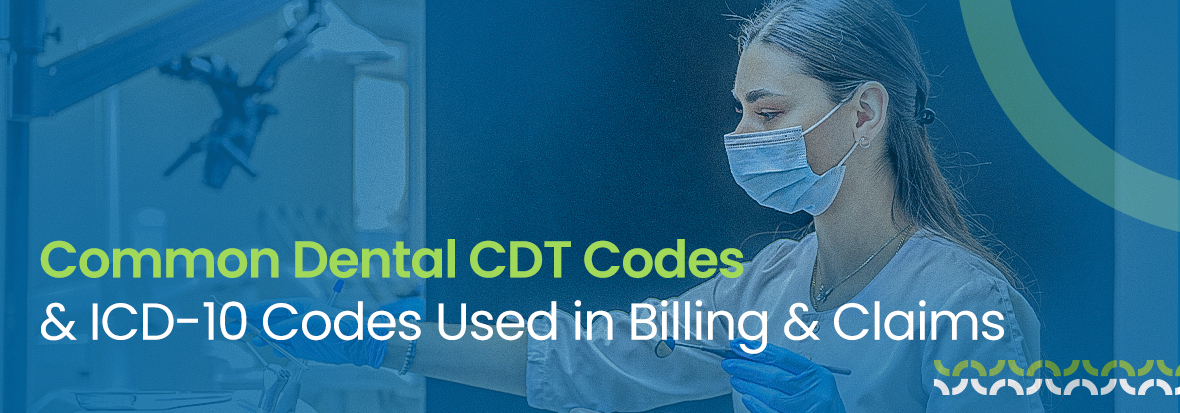Did you know dental claim denials cost U.S. practices billions each year? Many of these denials occur because of simple coding mistakes. For providers, choosing the right code and knowing why it matters can feel confusing.
This is why it is important to learn about common Dental CDT Codes and ICD-10 codes. In this blog, we’ll highlight the most common dental codes in dental billing. You’ll also get practical tips to help your team code with confidence and send cleaner claims. By the end, you’ll see how these codes work side by side to lower denials and speed up reimbursements for your practice.
What are CDT Codes?
CDT stands for Current Dental Terminology. Dental CDT codes are procedure codes created and maintained by the American Dental Association (ADA). They are used to describe what procedures were performed (cleaning, filling, extraction, crown, implant, etc.). Each code starts with a “D” (example: D1110 – Adult prophylaxis/cleaning). CDT codes are required on dental claim forms (ADA form) for insurance billing and reimbursement.
What are ICD-10 Codes in Dentistry?
ICD-10 stands for International Classification of Diseases. The number 10 stands for the 10th Revision. ICD-10 codes are diagnosis codes provided by the WHO. These codes are widely used in the U.S. by CMS and payers. ICD-10 codes describe the patient’s condition, disease, or reason for the visit.
For example, K02.53 is for Dental caries on the pit and fissure surface of a posterior tooth. They are required on medical claim forms like the CMS-1500. In some situations, they are also needed on dental claims to show medical necessity, such as oral surgery, trauma, or pathology.
Most Commonly Used CDT & Dental ICD-10 Codes
Here’s the list of dental codes that are most commonly used in dental practices in the USA.
| Category | CDT Code | ICD-10-CM Code |
|---|---|---|
| Diagnostic | D0120 – Periodic oral evaluation (established patient) | Z01.21 – Dental exam with abnormal findings |
| D0150 – Comprehensive oral evaluation (new/established) | Z01.20 – Encounter for routine dental exam | |
| D0210 – Intraoral complete series of radiographs | K03.81 – Cracked tooth / Z13.84 – Screening for dental disorders | |
| Preventive | D1110 – Prophylaxis, adult | Z01.20 – Routine exam |
| D1120 – Prophylaxis, child | Z00.121 – Well-child exam with abnormal findings | |
| D1206 – Topical fluoride varnish | Z29.3 – Encounter for prophylactic fluoride administration | |
| D1351 – Sealant, per tooth | K02.9 – Dental caries, unspecified | |
| Restorative | D2140 – Amalgam, one surface | K02.53 – Dental caries, posterior |
| D2330 – Resin-based composite, one surface, anterior | K02.52 – Caries on pit/fissure surface, anterior tooth | |
| D2391 – Resin-based composite, posterior, one surface | K02.53 – Caries on pit/fissure surface, posterior tooth | |
| D2740 – Crown, porcelain/ceramic | K03.81 – Cracked tooth | |
| Endodontics | D3310 – Root canal therapy, anterior | K04.0 – Pulpitis |
| D3320 – Root canal therapy, premolar | K04.01 – Reversible pulpitis | |
| D3330 – Root canal therapy, molar | K04.7 – Periapical abscess without sinus | |
| Periodontics | D4341 – Scaling & root planning, 4+ teeth per quadrant | K05.30 – Chronic periodontitis, unspecified |
| D4342 – Scaling & root planning, 1–3 teeth per quadrant | K05.32 – Chronic periodontitis, localized | |
| D4910 – Periodontal maintenance | K05.10 – Chronic gingivitis, unspecified | |
| Oral Surgery Dental Codes | D7140 – Extraction, erupted tooth | S02.5XXA – Fracture of tooth (initial encounter) |
| D7210 – Surgical removal of an erupted tooth | K01.1 – Impacted teeth | |
| D7230 – Removal of impacted tooth, partially bony | K01.1 – Impacted teeth | |
| D7240 – Removal of impacted tooth, completely bony | K01.1 – Impacted teeth | |
| Prosthodontics / Implants | D6010 – Surgical placement of the implant body | K08.21 – Loss of teeth due to trauma |
| D6058 – Abutment-supported porcelain/ceramic crown | K08.109 – Complete loss of teeth, unspecified cause | |
| D5110 – Complete denture, maxillary | K08.101 – Complete loss of teeth due to periodontal disease | |
| D5120 – Complete denture, mandibular | K08.102 – Complete loss of teeth due to caries | |
| D8680 – Orthodontic retainer (Essix Retainer) | K08.109 – Complete loss of teeth, unspecified cause (can also be paired with orthodontic aftercare codes such as Z46.3 – Fitting/adjustment of dental prosthetic device) |
Practical Tips for Accurate Coding in Dentistry
Accurate coding is the backbone of clean claims and timely reimbursements. Here are some practical tips for dental providers and billing teams:
Use the Most Specific ICD-10 Code Available
- Don’t settle for “unspecified” codes if documentation supports a more detailed code.
- Example: Instead of K02.9 (Unspecified caries), use K02.53 (Caries on pit and fissure surface, posterior tooth) if that’s what your notes show.
Match CDT and ICD-10 One-to-One When Possible
- A cleaning (D1110) should pair with a routine exam diagnosis (Z01.20).
- A surgical extraction (D7210) should pair with an impacted tooth diagnosis (K01.1).
- This direct link reduces insurer pushback.
Document in Clinical Language, Not Just Codes
- Example: Instead of writing only “D3330 – Root canal, molar,” document: “Patient presented with pulpitis in tooth #19 requiring root canal treatment (K04.0).”
- Strong notes = stronger claims.
Flag Cases That Need Medical Cross-Coding Early
- If a patient has trauma, infection, or sleep apnea appliances, note that the claim may go to medical insurance.
- This prevents delays when dental insurance denies coverage.
Pre-Verify Payer Preferences
- Some carriers want ICD-10 codes on all claims, even preventive visits.
- Keep a payer “cheat sheet” at the front desk so staff know which insurers require what.
Run a Weekly Denial Audit
- Review denied claims for coding errors (e.g., wrong ICD-10, outdated CDT).
- Fixing the root cause quickly prevents repeat mistakes.
Leverage Claim-Scrubbing Tools
- Modern practice management software and clearinghouses flag missing or mismatched codes before submission.
- This saves hours of rework and shortens A/R days.
Train the Team, Not Just the Billers
- Hygienists, assistants, and front desk staff should all understand basic CDT/ICD-10 coding.
- Many denials start with intake errors, not billing.
Conclusion
Accurate dental coding is not just paperwork. It directly impacts your reimbursements. It lowers claim denials and keeps your practice running smoothly.
Using Dental CDT Codes and ICD-10 codes the right way makes a big difference. They help you clearly show what care was provided and why it was medically needed.
Quick Checklist for Better Coding Practices:
- Always match each Dental CDT Code with the correct ICD-10 dental diagnosis codes list.
- Update both CDT and ICD-10 dental code sets every year.
- Record procedures and diagnoses clearly in the patient’s chart.
- Review denied claims often to spot repeated mistakes.
- Train your team on basic coding rules and documentation.
If coding feels too hard, you don’t have to manage it alone. A dental billing company, such as MedCare MSO, can handle your claims. They work with Dental CDT Codes every day. This helps reduce mistakes and speeds up payments. With experts handling billing, your practice can focus on patient care instead of paperwork.

